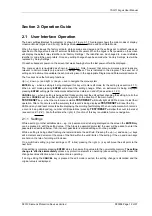
7SG11 Argus User Manual
©2013 Siemens Protection Devices Limited
P20006 Page 20 of 37
Note.
Depending upon the applied settings a TRIP could occur if the current is on for longer than the operating
time. This may be undesirable while measuring Pick-up and Drop-off levels. The ‘Fault Trigger’ setting (in the data
storage menu) can be used to disable tripping indication temporarily during this test, also the Low and High Set
elements may need to be temporarily turned ‘OFF’ in order to prevent unwanted instantaneous operations.
Timing
This test checks the accuracy of the main time delay characteristic (IDMTL/DTL). Select the current setting,
characteristic type and time multiplier setting as required. Then inject current at multiples of the setting.
The correct output contact must be programmed for the phase fault and earth fault elements. A time interval
meter must be connected to the correct terminals. The timer should be started by the source and stopped by the
trip contacts. Each pole should be tested. A secondary injection timing test circuit is illustrated in Figure 4-3.
Table 4-1 shows theoretical values for each characteristic curve with a time multiplier of 1.0. Record the actual
results in Table 4-5 and check that the measured times lie within 5% or 30ms of nominal time.
Table 4-1
IDMTL Timing Characteristic (Time in Seconds)
Curve
2 xIs
5 xIs
NI
10.03
4.28
VI
13.50
3.38
EI
26.67
3.33
LTI
120.00
30.00
DTL
-
-
4.2.3.2 Lowset and Highsets
Phase Fault poles can have up to two highsets and one lowset, also the Earth fault can have up to two highsets
and one lowset. The following tests should be applied to each element in the scheme.
The low/high set under test should be programmed to operate an output contact, which can then be monitored to
detect operation of the element.
Argus 2 and Argus 6 only:
If the Argus is to be employed for directional protection then all ‘Directional Control’
settings should be set to ‘OFF’ during the following tests.
Pick-up and Drop-off
Programme the current setting for the low/high set characteristic to the required level and set its time delay to
0.00 sec. Inject a level of current below the setting and increase the current until the output contact operates.
Record the Pick-up level for each pole in Table 4-6, Table 4-7 or Table 4-8 and confirm that in each case it occurs
within 5% of the applied setting.
For high levels of current the thermal limit of the Argus must not be exceeded. Refer to the performance
specification for the Argus, which defines the thermal limits. Manual testing runs the risk of exceeding the thermal
limit. When manually testing a high setting it is not considered necessary to establish the exact pick-up level and
the following procedure is recommended to ensure that the thermal limit is not exceeded:-
1. Switch on the test supply and quickly raise the current to just below 95% of the set value and then switch off
the test supply immediately. Switch back on and then off in quick succession to prove non-operation. Do this five
times with a delay between each test of about 10 seconds.
Test similarly at 105% of setting to prove operation. Switch off, reset the trip indication and then switch on and off
five times quickly to prove operation for each injection.
If a computer test set is being used then the pick-up level and timing can be measured provided that the
automatic test is set up to apply pulses of current to avoid exceeding the thermal limit.
Timing
The operating time should be tested with a current of 5 times setting applied and with the required time delay set.
Output contacts for the Low/Highsets must be programmed and a time interval meter connected to the correct
terminals.
The timer should be started by the source and stopped by the Low/Highset contacts. Each phase should be
tested.
Record the results in Table 4-9, Table 4-10 and Table 4-11 and confirm that the measured delays are within 5%
of the set values.
















































